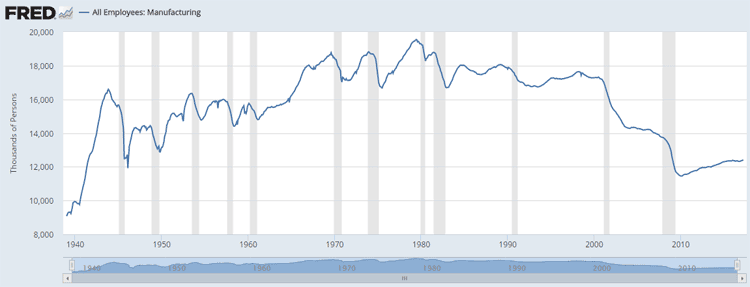What is the state of US manufacturing, a sector President Trump has promised to revitalize?
It depends on how you look at the numbers.
Supply Chain Digest Says... |
|
|
It is indisputable that the US has lost millions of manufacturing jobs.
As shown in the chart below from the Federal Reserve Bank of St. Louis, based on US Bureau of Labor Statistics data, US manufacturing employment peaked at nearly 20 million in 1979.
Just after the end of the Great Recession, manufacturing jobs fell to a recent low of around 11.4 million in early 2010 - down almost 9 million from that 1979 peak.
To consider what those numbers mean, it is important to understand how the BLS defines manufacturing employment. It is based on how a given facility or site is categorized. If it is categorized as a manufacturing site, all employees in the facility, the plant manager and white collar or other office employees are counted as manufacturing workers, as well of course are true shop floor workers.
Conversely, workers for a "manufacturing company" that do work in an office building of any type not classified as a manufacturing site are not included in manufacturing employment numbers.
The BLS does separately also track that actual number of shop floor numbers, but the commonly cited manufacturing employment data are usually based on the broader definition offered above.
While the picture over the past few decades has obviously not been a good one, with millions of jobs lost to productivity gains and offshoring, the trend is actually headed in the right direction - albeit modestly.
US Manufacturing Employment

Source: Federal Reserve Bank of St. Louis, from BLS Data
For example, the number of US manufacturing job openings in March rose to 394,000, the Department of Labor reported last week, matching the highest level since April of 2006.
Actual hiring in the manufacturing sector also jumped to 322,000, a level not seen since the early months of the recession, right before manufacturing hiring fell off a cliff.
Monthly hires were also up nearly 25% versus last March.
What's more, 922,000 manufacturing hires were made during the first three months of this year - up notably from the 828,000 jobs filled made over the same period in 2016 and the best figures since 2008.
(Article Continued Below)
|
CATEGORY SPONSOR: SOFTEON |
|
|
| |
|
|
That means that right now there are about 12.4 million US manufacturing employees - up almost one million from the bottom in 2010.
Slowly but somewhat surely, US manufacturing may be coming back.
Strong demand for workers from domestic manufacturers is believed to be partially driving the strong jobs openings number. But a skills mismatch - meaning a lack of qualified employees to operate what can be advanced or complex manufacturing equipment - is also believed to be a factor. This is something the US has to find some way to address to stoke the economy, the manufacturing sector, and job growth.
US Public Believes Strong Manufacturing Sector is Important
It's not surprising, but a recent survey from Deloitte finds that there is strong public support for a US manufacturing renaissance.
For example, the Deloitte survey found that more than 8 in 10 respondents see manufacturing as vital to America's livelihood. 83% believe U.S. manufacturing is critical to economic prosperity, and 81% feel it is important to maintaining their standard of living.
What's more 76% of respondents believe the U.S. needs a more strategic approach to developing its manufacturing base, the same number that believe the U.S. should further invest in the manufacturing industry.
71% of respondents believe that the U.S. should ensure long-term, stable funding for programs that spur innovation and advanced manufacturing.
Deloitte says that the demand for high-skilled manufacturing positions is expected to soar over the next decade with 3.5 million manufacturing jobs becoming available between 2015 and 2025 as the industry evolves and baby boomers continue to retire.
Deloite's 2017 Manufacturing Perceptions Survey polled a nationally representative sample of 1,030 Americans across all 50 states in December 2016, but the results were just released last week.
Any reaction to this snapshot of US manufacturing employment? Does public support of the manufacturing sector mean anything in the end? Let us know your thoughts at the Feedback section below.
Your Comments/Feedback
|
|
Joe Mcculloch
Machinist for the sciences, Baylor University |
Posted on: May, 16 2017 |
|
Once upon a time a long time ago having a trade was a respected way of making a living but puplic perception has changed over the years. Students are pushed toward a four year degree and heavy debt and a two year technical degree is taboo. All of the trades have suffered but manufacturing has suffered the most. Today's machine shop is nothing like our father's time and the technology demands computer literacy. Shop classes in public schools are nonexsistent and today's children are unaware of trades. We haven't had any apprenticeship programs since WW2 and we are so far behind the times that I am not sure we can catch up enough to be competitive with the world market. Public perception must change to encourage manufacturing as a career if we are to succeed.
|
|
|